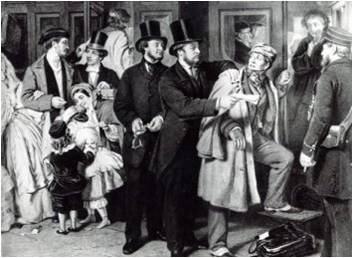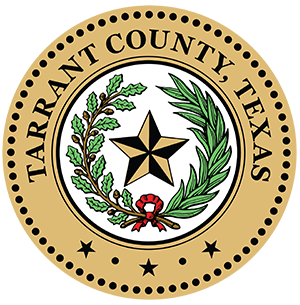History of the Constable
History of the Constable
History of the Constable and the Constable in Texas
Established in France in the Fifth Century - in America 1632 - in Texas 1823
Constable is the oldest law enforcement position in the world. The position originated from the Eastern Roman Empire. History records constables in France in the beginning of the fifth century, when they were known as the Counts of the King's Stables, which was later merged into "Counstables". The position was usually of noble birth. The count was the First Officer of the Crown of France and later became known as the Constable of France. His primary duty was commander of the King's armies and upheld the Crown Rule of Orders. The Constable was the only one permitted to carry the King's sword. According to French authors, the Constable was changed in France in 1600's by King Louis XIV to Guarde De Corps.

Early constables in England serving a warrant
In England, by the turn of the sixth century they were the Chief Household Officers. In the year 871 AD, King Alfred of England, declared the constable was the highest judge in the military offenses and in matters of chivalry and honor. He was also named by the King to be the supreme arbitrator in tilts, tournaments and martial displays. The Shire Reeve "Sheriff" originated in 920 AD, almost 50 years after the constable existed in England. Becoming noted peacekeepers under King William "The Conqueror" in 1066, the constables' responsibilities were expanded with the adoption of the Magna Carta -- which not only became the pattern for most of the world's Constitutions, but also described constables in written law. In 1825, the Statute of Winchester constituted two constables for every 100 people. Their duties: to prevent issues along the roadways. Constables have served the justice court system since 1362. In 1583, Constable William Lambard published the first policy and procedures manual for law enforcement. In 1700's, records indicate the position was elected by the parishioners until the Metropolitian Police Force was established in 1829. Today in England, the entry level position is a constable and unpaid officers are called Special Constables.
In America, the first constable was appointed in the Plymouth Colony in 1632. During that time, the leading official was the justice of the peace. The constable enforced the orders of Colonial and County officials in both civil and criminal matters. The Sheriff was appointed two years later in 1634. Currently only 23 states have Constables -- Alabama, Alaska, Arizona, Arkansas, Connecticut, Deleware, Georgia, Kentucky, Louisiana, Massachusetts, Maine, Michigan, Mississippi, Nevada, New Jersey, New York, Pennsylvania, Rhode Island, South Carolina, Tennessee, Texas, Utah and Vermont. Each state varies from elected to appointed, city or county/parish, to legal jurisdiction and authority.
In Texas on March 5, 1823, Constable Thomas Alley was appointed in Stephen F. Austin's original colony and sworn in by Judge John Tumlinson. Later, another constable was sworn in by Judge Tumlinson making the two constables the first law enforcement in Texas. Three months later, with all the issues across Texas, the original two stayed to protect the local colonies and 10 others -- lead by former Judge Tumlinson -- were sent out to protect the range and guard the frontier. These men later formed the Texas Rangers. Judge Tumlinson is known as the first Texas Ranger and believed to be the first Ranger killed in the line of duty. In 1828, a Sheriff was appointed in Texas to hold the prisoners within each county.
The Constables and Rangers, combined, became an active group of roughly 200 men. In 1836, that same group was strategically used to go in and move out the Native Americans from the areas surrounding San Jacinto to allow Sam Houston's army the opportunity to quietly attack Santa Anna at the battle of San Jacinto. The constable was later written into Constitutional law and was the only law enforcement defined by the original Texas Constitution. At that time, Sam Houston formally separated the two groups. The constable would be elected by the people in each local area, known as precincts. The Texas Rangers became an officer of the new Republic. Both groups would be commissioned and report directly to the governor. Today that still holds true.
During the civil war, most constables joined their brothers, the Texas Rangers, and fought for the Confederate Army. From 1869 to 1872 there were no elected constables in Texas and only a couple appointed by a few local justices of the peace. The Constitution of 1876 mandated once again that constables be elected at the local precinct level.
Today, constables are elected and serve a four-year term, which runs on the same cycle as the President of the Untied States. The law defines that the constables are associate members of the Texas Department of Public Safety under Texas Government Code 411.009, which is defined and given the same authority. They are the officers of the justice of the peace court. Each constable will appoint deputies to work under his authority. Each deputy is given the same authority as the constable. A constable is considered to be the "Peoples Police" because of their Constitutional origin and local elected representation of the people.
One sheriff is elected to each county and is primarily responsible for the operation of the jail and upholding law and order. Each Texas County is divided into precincts. Counties will have between four and eight precincts depending on size (Tarrant County has eight), but no less than four. Each precinct has an elected law enforcement representative (constable) and a local judicial representative (justice of the peace). It is the constable's responsibility to observe and uphold the law and order for that precinct.
Constable is given Constitutional authority to enforce both civil and criminal laws. State and city police officers are given the authority to only enforce criminal laws. There are approximately 770 elected constables in the State of Texas. To this day, Texas Constables and Texas State Troopers all work very close together and both use the justice of the peace as their primary judge/court. Constables have the authority to enforce almost every law in the State of Texas. It is not uncommon in Texas for constable offices to have traffic divisions or criminal investigation divisions as well as patrol and special response teams.
Many constables operate differently across the state. Constables have continuous jurisdiction and like the sheriff, they report only to the governor and citizens that elect them to serve. The operation of the constable's office vary, depending upon the expectations of the community and the elected constable.

Content copyright 2005- 2015. Tarrant County Constable's Office Precinct 7. All rights reserved.

 TARRANT COUNTY, TX
TARRANT COUNTY, TX

 Constable Precinct 7
Constable Precinct 7